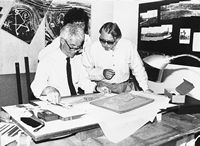
|
 |
Birth of a Hospital
Naissance d'un hôpital
|
FRANCE / 1991 / French / Color / 16mm / 67 min
Director: Jean-Louis Comolli
Based on the book by: Pierre Riboulet
Adaptation: Jean-Louis Comolli, Arnaud des Pallières
Photography: Jacques Pamart
Editor: Anne Baudry
Sound: Frank Mercier, Jean-Pierre Laforce
Producer: Muriel Rosé
Production Company: SEPT,INA
Source: Ministère des Affaires Etrangères, L'Institut
Franco-Japonais de Tokyo
 |
|
Jean-Louis
Comolli

Film critic and filmmaker. Joined Cahiers du cinema in 1962
and served as its editor-in-chief from 1966 to 1971. In 1968 directed
his first documentary film Les Deux Marseillaises. Directed
his first narrative feature La Cecilia in 1976. Since the 1980s
he has been fully devoted to documentary filmmaking, and his filmography
includes Toto, Une Anthologie (1979), La France à
la carte (1986), Marseille de de pere en fils (1989), Un
American en Normandie (le jour J de Samuel Fuller) (1994), and
Musique de films: Georges Delrue (1994), a portrait of the
late celebrated film composer. Comolli is also an active teacher of
cinema. He is the co-chairman of the department of film direction
at FEMIS (the French national film school) and he also teaches at
Paris University 8th and in Barcelona. He is an expert in music and
also works as a Jazz critic. He is now completing his latest film
on Spanish anarchists in the years 1931-1936; Vies et morts de
Buenaventura Durutti, ananchiste (1999). |
The architect Pierre Riboulet was commissioned to build a children's
hospital. Based on his diary of creation covering five and a half
months, the film follows the process of how an architect, drawing
inspiration from the location, goes about giving form to a building.
At the same time the architect considers a hospital's role in supplying
hope and helping children in their struggles against sickness.
At
the Risk of the Real - Juror's statement
Our fantasies, like our needs, are scripted. An invisible hand aligns
the procedures that are to lead us. Societies slide smoothly from
the age of representation - |the theater of institutions, comedies
or tragedies of power, spectacles about power relations - to that
of programming: from the act to the script. The citizen is no longer
asked to be a spectator - active, at once both at stake in representation
and actor by delegation - but to stay in his place as consumer, powerless
even to understand the program which he performs. Too unequal, the
game is no longer a game.
Faced with more and more scripting of social and intersubjective relations
as publicized (and finally guaranteed) by the "realist"
model of the televised serial, documentary has no choice but to be
made at the risk of the real. The imperative of how to film, which
lies at the heart of the filmmaker's work, is asked here with most
violent necessity: the question is not how to make a film, but how
to ensure that there is film. The practice of documentary cinema depends
not on circuits of financing or possibilities for distribution but
simply on the good will - on the grace - of that which or whom we
choose to film, whether individual, institution or group. Desire is
at the command post, and the conditions of an experience part of the
experience. In opening itself to that which menaces its own possibility
(the real which menaces the scene), documentary cinema at the same
time saves the possibility of a relief for representations: it is
the documentary path which snakes from Germany, Year Zero to
The Moontrap, from Petit à petit to Life and Nothing
More. Documentary films are not only - open onto the world - they
are crossed by it, pierced by it, transported by it. It is a fragile
fertility, and documentary cinema sees itself placed and replaced
incessantly in a sort of obligation to reinvent itself; faced with
programming which dominates and attempts to reduce all reality to
a screenplay, it is necessary to find modes of narration which bring,
if this is the term, the real into the narrative. We can say this
in another way: if film is truly the art which brings together the
gaze and the ear, what possibility still exists even to see and hear
in our hyperspecularized societies? |
  |
|
 next next
|
COPYRIGHT:Yamagata International Documentary Film Festival Organizing Committee |